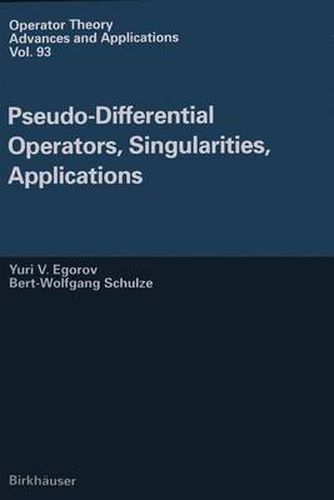Readings Newsletter
Become a Readings Member to make your shopping experience even easier.
Sign in or sign up for free!
You’re not far away from qualifying for FREE standard shipping within Australia
You’ve qualified for FREE standard shipping within Australia
The cart is loading…






This title is printed to order. This book may have been self-published. If so, we cannot guarantee the quality of the content. In the main most books will have gone through the editing process however some may not. We therefore suggest that you be aware of this before ordering this book. If in doubt check either the author or publisher’s details as we are unable to accept any returns unless they are faulty. Please contact us if you have any questions.
Pseudo-differential operators belong to the most powerful tools in the analysis of partial differential equations. Basic achievements in the early sixties have initiated a completely new understanding of many old and important problems in analy- sis and mathematical physics. The standard calculus of pseudo-differential and Fourier integral operators may today be considered as classical. The development has been continuous since the early days of the first essential applications to ellip- ticity, index theory, parametrices and propagation of singularities for non-elliptic operators, boundary-value problems, and spectral theory. The basic ideas of the calculus go back to Giraud, Calderon, Zygmund, Mikhlin, Agranovich, Dynin, Vishik, Eskin, and Maslov. Subsequent progress was greatly stimulated by the classical works of Kohn, Nirenberg and Hormander. In recent years there developed a new vital interest in the ideas of micro- local analysis in connection with analogous fields of applications over spaces with singularities, e.g. conical points, edges, corners, and higher singularities. The index theory for manifolds with singularities became an enormous challenge for analysists to invent an adequate concept of ellipticity, based on corresponding symbolic structures. Note that index theory was another source of ideas for the later development of the theory of pseudo-differential operators. Let us mention, in particular, the fundamental contributions by Gelfand, Atiyah, Singer, and Bott.
$9.00 standard shipping within Australia
FREE standard shipping within Australia for orders over $100.00
Express & International shipping calculated at checkout
This title is printed to order. This book may have been self-published. If so, we cannot guarantee the quality of the content. In the main most books will have gone through the editing process however some may not. We therefore suggest that you be aware of this before ordering this book. If in doubt check either the author or publisher’s details as we are unable to accept any returns unless they are faulty. Please contact us if you have any questions.
Pseudo-differential operators belong to the most powerful tools in the analysis of partial differential equations. Basic achievements in the early sixties have initiated a completely new understanding of many old and important problems in analy- sis and mathematical physics. The standard calculus of pseudo-differential and Fourier integral operators may today be considered as classical. The development has been continuous since the early days of the first essential applications to ellip- ticity, index theory, parametrices and propagation of singularities for non-elliptic operators, boundary-value problems, and spectral theory. The basic ideas of the calculus go back to Giraud, Calderon, Zygmund, Mikhlin, Agranovich, Dynin, Vishik, Eskin, and Maslov. Subsequent progress was greatly stimulated by the classical works of Kohn, Nirenberg and Hormander. In recent years there developed a new vital interest in the ideas of micro- local analysis in connection with analogous fields of applications over spaces with singularities, e.g. conical points, edges, corners, and higher singularities. The index theory for manifolds with singularities became an enormous challenge for analysists to invent an adequate concept of ellipticity, based on corresponding symbolic structures. Note that index theory was another source of ideas for the later development of the theory of pseudo-differential operators. Let us mention, in particular, the fundamental contributions by Gelfand, Atiyah, Singer, and Bott.